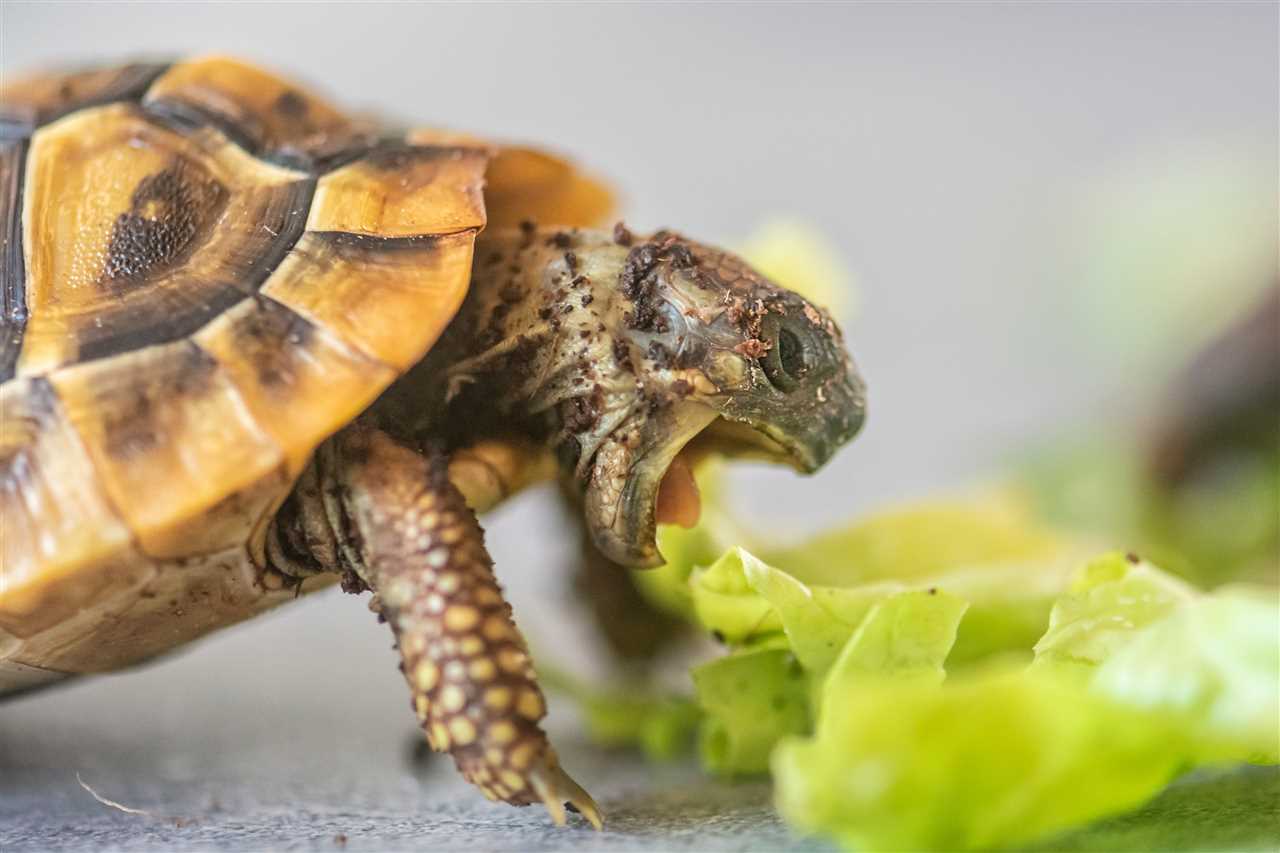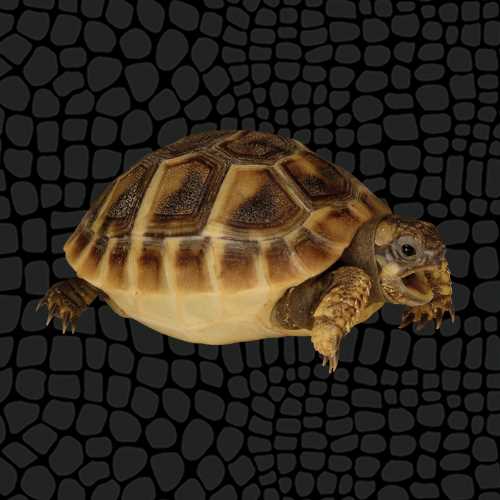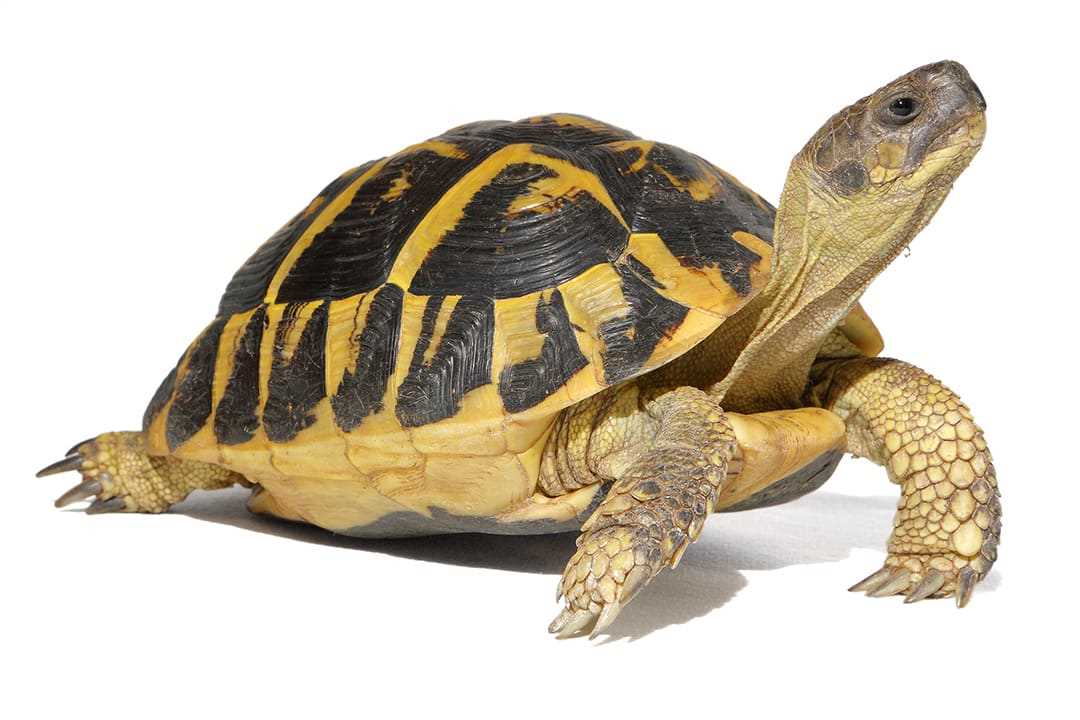
In addition to the habitat, the diet of a Hermann tortoise is crucial for its health and well-being. These tortoises are herbivores, so their diet should consist mainly of leafy greens and vegetables. Foods like kale, dandelion greens, and bell peppers are excellent choices. It’s also essential to provide a calcium supplement to ensure proper shell and bone development.
Another important aspect of caring for a Hermann tortoise is regular veterinary check-ups. Finding a reptile veterinarian experienced in treating tortoises is essential to ensure your pet’s health. Regular check-ups can help detect any potential health issues early on and prevent them from becoming more serious.
By following these tips and guidelines, you can provide the best care possible for your Hermann tortoise. Remember to create a suitable habitat, provide a balanced diet, and schedule regular check-ups with a reptile veterinarian. With proper care, your Hermann tortoise can live a long and healthy life.
1. Enclosure
2. Substrate

3. Temperature and Lighting
Hermann tortoises require a basking spot with a temperature range of 90-95 degrees Fahrenheit. The rest of the enclosure should have a cooler area with temperatures ranging from 75-85 degrees Fahrenheit. UVB lighting is also essential for the synthesis of vitamin D3, which is necessary for proper calcium absorption.
4. Humidity
Maintaining the right humidity levels is important for the health of your Hermann tortoise. Aim for a humidity level of 50-60%. This can be achieved by misting the enclosure daily and providing a shallow water dish for your tortoise to soak in.
5. Hiding Spots and Enrichment
Providing hiding spots and enrichment opportunities is important for the mental stimulation of your Hermann tortoise. Adding rocks, logs, and branches to the enclosure can create hiding spots and climbing opportunities for your tortoise. Additionally, providing fresh vegetation and toys can keep them entertained.
6. Cleaning and Maintenance
Regular cleaning and maintenance of the enclosure are necessary to keep your Hermann tortoise healthy. Remove any uneaten food and clean the water dish daily. Replace the substrate regularly to prevent the buildup of bacteria and parasites.
By following these guidelines and providing the right habitat for your Hermann tortoise, you can ensure that they live a happy and healthy life.
Providing the Right Diet for Your Hermann Tortoise
Hermann Tortoises are herbivores, which means their diet should consist primarily of plant-based foods. They have specific nutritional requirements that need to be met in order to keep them healthy. Their diet should be rich in fiber, calcium, and a variety of vitamins and minerals.
In addition to leafy greens, you can also include vegetables such as carrots, bell peppers, and squash. These vegetables add variety to their diet and provide additional nutrients.
Supplementing their Diet
You can offer calcium supplements in the form of powdered calcium or cuttlebone. These can be sprinkled on their food or placed in their habitat for them to consume as needed. Multivitamin supplements can also be used to ensure they are getting all the necessary vitamins and minerals.
It is always a good idea to consult with a veterinarian or a reptile specialist to ensure that you are providing the right diet for your Hermann Tortoise. They can offer guidance and recommend specific brands of food and supplements to meet your tortoise’s dietary needs.
By providing the right diet, you are taking a proactive approach to caring for your Hermann Tortoise and ensuring their long-term health and well-being.
Caring for a Hermann Tortoise: Maintaining the Proper Temperature and Humidity Levels
One of the most important aspects of caring for a Hermann Tortoise is maintaining the proper temperature and humidity levels in their habitat. These reptiles are ectothermic, meaning their body temperature is regulated by their environment. Failure to provide the correct temperature and humidity can have serious consequences for their health and well-being.
Here are some tips and guidelines to help you ensure the right conditions for your Hermann Tortoise:
- Temperature: Hermann Tortoises require a basking area with a temperature range between 85°F (29°C) and 95°F (35°C). The rest of the habitat should be kept at a cooler temperature, around 75°F (24°C) to 85°F (29°C). It is essential to provide both a warm and a cool area in their enclosure, so they can regulate their body temperature as needed. The temperature should be monitored using a thermometer placed at tortoise level.
- Lighting: Along with the temperature and humidity, proper lighting is crucial for the well-being of a Hermann Tortoise. They require access to both UVB and UVA light. UVB light is necessary for the synthesis of vitamin D3, which is vital for the absorption of calcium and the prevention of metabolic bone disease. UVA light helps stimulate natural behaviors and is essential for the overall psychological well-being of the tortoise. Use a reptile-specific UVB/UVA lamp and ensure it is replaced regularly according to the manufacturer’s recommendations.
- Thermoregulation: Hermann Tortoises are adept at thermoregulation and will move between warmer and cooler areas to regulate their body temperature. Provide various hiding spots, logs, and rocks in their habitat, so they can seek shelter and adjust their body temperature as needed. This will allow them to maintain a healthy and active lifestyle.
By providing the proper temperature and humidity levels, along with appropriate lighting and hiding spots, you can ensure the overall well-being and health of your Hermann Tortoise. Regularly monitor the habitat’s conditions and make adjustments as needed to create a comfortable and thriving environment for your pet tortoise.
Caring for a Hermann Tortoise: Handling and Socializing
Handling and socializing with your Hermann tortoise is an important part of caring for their overall well-being. While tortoises may not require as much social interaction as other pets, it is still beneficial to create a bond and provide them with mental stimulation.
Here are some tips for handling and socializing with your Hermann tortoise:
1. Start with Short and Gentle Handling Sessions
When first introducing your tortoise to handling, start with short sessions to allow them to acclimate to the experience. Use gentle and slow movements, gradually increasing the duration of the sessions over time as your tortoise becomes more comfortable.
2. Support their Shell Properly

3. Create a Safe Environment

Before handling your tortoise, ensure that the environment is safe and free from any hazards. Remove any small objects or chemicals that could be harmful if ingested. Additionally, make sure that there are no gaps or openings where your tortoise can escape.
4. Observe Their Body Language
5. Provide Environmental Enrichment
Hermann tortoises benefit from environmental enrichment, which can include activities such as exploring a tortoise-safe outdoor enclosure or providing them with items to climb on or hide under. These enrichments can help to stimulate their natural behaviors and provide mental and physical stimulation.
6. Introduce Tortoise-Safe Companions
Remember, each tortoise is unique, and their comfort level with handling and socializing may vary. Always monitor their behavior and adjust your approach accordingly. With time and patience, you can develop a bond with your Hermann tortoise and provide them with a fulfilling and enriching life.
Recognizing and Treating Common Health Issues in Hermann Tortoises
Common Health Issues
There are several common health issues that Hermann tortoises may encounter:
- Shell problems: Shell infections, shell rot, and shell deformities can occur in tortoises. These issues can be caused by poor diet, improper husbandry, or rough handling. Regularly inspecting your tortoise’s shell and providing a proper diet and habitat can help prevent these problems.
- Parasites: Tortoises can be affected by internal and external parasites, such as worms and mites. Symptoms may include weight loss, decreased appetite, and a dull appearance. Regular veterinary check-ups and maintaining a clean habitat can help prevent parasite infestations.
- Vitamin deficiencies: Inadequate UVB exposure and a lack of proper supplementation can lead to vitamin deficiencies in tortoises. This can result in metabolic bone disease, which affects the tortoise’s shell and bones. Providing UVB lighting and a well-balanced diet can help prevent vitamin deficiencies.
Treatment and Prevention

Treatment for common health issues in Hermann tortoises may include medication, dietary changes, or adjustments to the tortoise’s habitat. Following the veterinarian’s advice and administering any prescribed medication or supplements is crucial for the tortoise’s recovery.
To prevent health issues in Hermann tortoises, provide a clean and appropriate habitat, offer a well-balanced diet, and ensure adequate exposure to UVB lighting. Regular veterinary check-ups are also important to catch any potential health problems early on.
